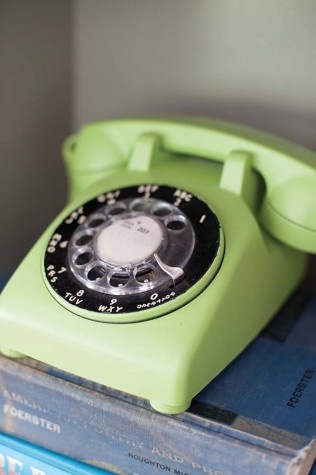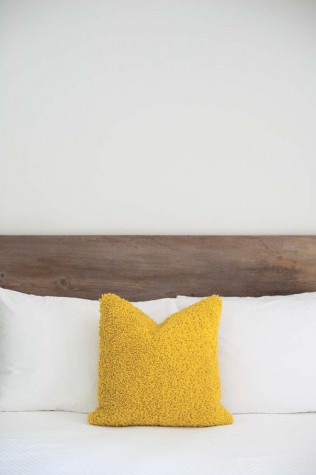Vintage Tourism
FEATURE – May 2014
By Debra Spark | Photography Nicole Wolf
A Kennebunkport motor lodge with retro flair is renovated for family fun
If you’re an American of a certain age—the age that lived rather than watched Mad Men—you may associate childhood summer vacations with a packed station wagon, an endless drive, a brief stop for fried clams at Howard Johnson’s, and eventually the arrival at a motor lodge. Then a quick change into a swimsuit and a leap into a swimming pool. Ah, relief. No more fighting with your sibling in the backseat of the car—just the fun of the water. Later Ping-Pong, a board game, dinner, and playing till dark.
The Lodge on the Cove is devoted to such pleasures. It’s a 1970 motor lodge that was updated last year by the Kennebunkport Resort Collection, which owns and operates multiple upscale hotels and restaurants in the Kennebunks. For 30 years, the Lodge on the Cove was the Village Cove Inn, a Kennebunkport fixture located between a tidal cove and a residential road. It wasn’t fancy. It was the sort of place you might go to sing karaoke.
Two years ago, Debbie Lennon, the managing and operating partner of KRC; Tim Harringon, the managing partner and creative director of KRC; and their partners purchased the Village Cove Inn. Initially they considered building a family resort with a pool, waterslides, and waterfalls, but they thought it best to run the business as it was for a year to get a feel for the 30-room property. When the time was up, the idea of waterslides and waterfalls struck them as misguided. Instead, they wanted to stick with elements that characterize their other luxury properties: a lobby with a lively social space and a restaurant that offers interesting food and beverages. The twist would be that at the Lodge on the Cove this would all be kid-friendly—in a big way. People would pull up, pile out of their car with their many bags, and land in a place that is stylish, upbeat, and, more or less, kid-proof.
Although KRC has used outside construction firms and designers to build or renovate some of their other properties, they decided to keep the Lodge on the Cove effort largely (though not completely) in-house. Builder Tom Nill, Lennon’s husband, ran the project. Meanwhile Christy Reid (who has been a general manager and/or project manager for three different KRC properties) and Kennebunkport interior designer Krista Stokes were responsible for the design. “The design philosophy was lighthearted and happy, approachable and unpretentious. Vintage tourism,” says Stokes. But, of course, the Lodge on the Cove isn’t just any old motor lodge anywhere. It is in coastal Maine, and Reid and Stokes wanted the design to reflect that as well.
First, though, KRC needed to do some basic renovations, gutting what had been the lobby space and the downstairs tavern and redoing all the rooms. Now when you visit the Lodge on the Cove, it looks like a motel…and it doesn’t. The various white buildings that compose the property have the right profile: low with outside walkways. But the guest room doors are a vibrant light green, the room numbers are teal and oversized, and the sitting areas on the walkways outside each room can be closed off from one another with blue, white, and tan curtains.
To check in at the Lodge on the Cove, you enter a large, bright octagonal lobby that suggests a rest stop that’s had a major facelift. It’s an airy space with big windows and clean white walls, against which the orange, blue, and gray of the seating area furniture looks particularly cheerful. The original pebbled drop ceiling was removed to reveal metal rafters. Those rafters are now painted white, and pickled wood paneling was used for the rest of the high ceiling. Where there once was a large copper fireplace, there is now a stone fireplace surrounded by bookcases, on which sit custom book sets and books covered in vintage wallpaper, gift wrapping, and handmade paper. Around the books sit old cameras and binoculars that Reid and Stokes spray painted in vibrant colors to further decorate the space.
If you’re the typical visitor, your next stop is your room. The guest rooms come in four different color palettes, each offering a surprisingly different feel although the rooms are otherwise similar. Each room has a single wall of zig-zag wallpaper, a large Dash and Albert rug, and a bed with a free-floating headboard that is either made of wide-planked old barn board or of painted pine bordered by rope. (The headboards are made by local craftsmen Nick Libby and Chuck Reid, who is designer Christy Reid’s father.) The rooms also have custom built-in shelves that serve as night tables, two chairs (original to the motor lodge but re-covered in bright fabrics by Vida Urbaite of Kennebunkport), and a table made by welder and lobsterman Alan Inzerillo, who spirals lobster rope into a circle for his table tops and uses metal for his bases. Each bathroom has a simple open vanity and towel hooks made of boat anchors.
Back in the lobby, one of the first things a visitor would likely notice is a large painting of what seems to be a wilderness guide, holding binoculars and leaning against a boat. The painting is by David Edward Allen, as are the paintings in the individual guest rooms. In fact, Allen is responsible for a whopping 110 paintings in the hotel, all produced within the space of three months. These include larger paintings of lobster boats, fish shacks, the old town firehouse, and trees, as well as smaller still lifes of cameras, binoculars, and phones. Allen’s inspiration for this work ran from pop art painter Wayne Thiebaud for the smaller pieces to Fairfield Porter for the larger pieces to N.C. Wyeth and old L.L.Bean catalog covers for the big painting in the lobby. Once hung, Allen says the large piece pleased him for suggesting the sort of WPA mural you might see in an old post office, a nice fit with the Lodge on the Cove’s retro inclinations.
From the lobby, a wrought-iron spiral staircase takes you downstairs into what is now the Dory, a restaurant with a wall of glass doors that open onto an outdoor play area with a heated saltwater pool, Ping-Pong table, chaise lounges, rocking chairs, old-fashioned upright bicycles, and yard games. Here the colors are all vibrant greens and blues with an occasional red: the forest green of the rockers, the light green of the chaise lounges, the teal of the high shell chairs that serve as bar stools, and the red and white of the stools pulled up to custom white and brown tables made by Chuck Reid. The bar top is made of recycled coconut husks that have been beveled and sealed, and any drink that passes over its top comes in a plastic vessel (kids, swimming pools, and glass being an inadvisable combination).
“It reminds me of Cape Cod,” Lennon says of the Lodge on the Cove. “It’s so Dirty Dancing,” says Stokes. As for Reid, who grew up in Kennebunkport, the motor lodge reminds her of her childhood. She remembers being a little girl and going to the Village Cove Inn to swim and have lunch with her friend’s parents. Now, Reid says, “It’s nice to be back in that era.”



































